
Digital product training
When product knowledge becomes customer success
A printer is no longer a simple office device – modern models take on complex tasks, offer numerous accessories and are used in specialized fields of application. If you want to sell, install or support such a device, you need more than just a data sheet. Stefan, a new member of the technical sales team, is no exception. Before he can convincingly present the printer to his customers, he really needs to understand it: What are the core functions? What is the device made for? What accessories are available – and how does commissioning work?
This is exactly where our digital product training comes in. In a modular e-learning course, Stefan learns everything he needs to know about the product – practically, interactively and at his own pace. As soon as the basics are in place, the acid test follows: a realistic sales simulation. A fictitious customer asks critical questions, compares with competitor products and expects convincing answers. Those who know not only the product but also the market will master the challenge. And that is precisely the aim of this product training: to build up technical understanding, gain confidence – and present the product with conviction.
Product knowledge alone is not enough
The problem
Anyone who has to sell or explain technical products such as specialized printers knows the dilemma: traditional product training often consists of dry presentations, data sheets or lengthy PDFs. Although the information is complete, it is rarely comprehensible, let alone practical. What the device can really do, what it is intended for and how to get customers excited about it often remains shrouded in a fog of technical details. And when it gets serious – in a direct conversation with a critical customer – theoretical knowledge alone is no help. This is precisely where the weakness of traditional formats becomes apparent: they do not prepare you for real application situations. Neither for specific product benefits, nor for objections, comparisons with competitors or spontaneous questions. This leads to employees learning – but not performing confidently. And this is exactly what is needed in product sales: confidence, strong arguments and a real understanding of the product.
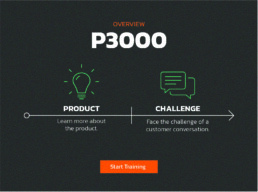
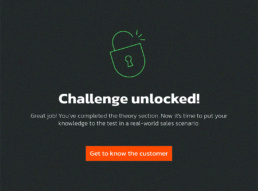
Skillpractice
The solution
In our digital product training, after the theoretical part, learners get straight into the exciting part of real life: talking to customers. The Sales Challenge is activated with just one click – and Stefan, who previously got to know the product and its functions, now becomes a sales representative himself. In an interactive simulation, Stefan answers the questions of a fictitious customer: What are the specific benefits of the product? Why is it better than the competitor’s model? Which additional modules make sense in the individual use case? The learners experience a realistic sales pitch, make decisions, respond to objections – and immediately notice whether they have really internalized what they have learned. This turns knowledge into action competence – and passive learning into an active role reversal with real practical relevance.
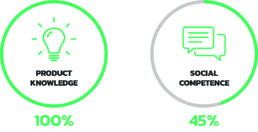
Technical know-how meets communicative strength
In the end, it’s not just what you say that counts – it’s how you say it. The digital product training therefore not only tests whether Stefan has understood the product, but also how he presents himself in the sales pitch: friendly, clear, empathetic. The evaluation of the challenge shows both – product knowledge and social skills. Because in customer communication in particular, the tone, the start of the conversation and the type of argumentation determine whether a product is convincing. This is an aspect that is often neglected in traditional training courses – and is specifically trained here.

Product knowledge is put to the test
Now it's getting serious: the customer has questions
The challenge is activated – and Stefan is in the middle of a conversation with Thomas Becker, a buyer from a fictitious company. Now it becomes clear what the digital product training really achieves: Stefan not only has to explain the new printer clearly, but also respond to critical questions, highlight advantages and skillfully differentiate it from the competition. Thomas is well prepared – and asks specific questions about functions, areas of application and accessories. A realistic sales situation that challenges – and trains – product knowledge and conversation skills in equal measure.
Conversation simulation with brains - apply knowledge, show impact
Every answer counts
Thomas asks – and Stefan answers. In the interactive conversation simulation, digital product training becomes a real challenge: Thomas uses speech bubbles to ask specific questions about the printer, possible areas of application and accessory options. Stefan chooses from several possible answers – some obviously correct, others more subtle. Behind each selection are hidden single or multiple choice questions, packaged in realistic conversational situations. This not only tests specialist knowledge, but also the ability to communicate confidently and in a customer-oriented manner. An effective method for applying knowledge in context – and training social skills along the way.
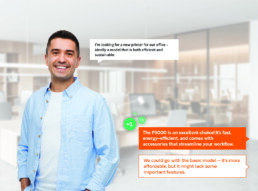
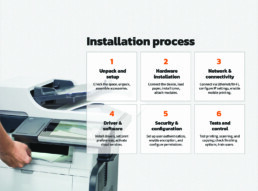
Commissioning made easy: step by step to practice
Selling is good - understanding is even better
A good sales pitch is convincing – but real expertise is demonstrated when the technical details are also right. That’s why digital product training not only includes product knowledge, but also safe handling. Learners practise the installation process of the printer in the theory section – visually accompanied, interactively conveyed and clearly structured. This means that they will later know exactly how to connect, set up and commission the device correctly. A training course that not only explains what the product can do, but also shows how it works.
Know accessories - and sell them in a targeted manner
More than just the basic device
A product rarely sells on its own – the real added value often lies in the accessories. This is precisely why digital product training also integrates this important aspect: learners not only learn what the printer can do in its basic configuration, but also which optional accessories are available and for which application scenarios they are relevant. This enables them to identify specific needs in discussions with customers, make recommendations and expand the range of functions accordingly. An important building block for successful cross-selling – and a real plus for product success.
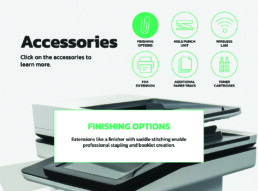
Product knowledge that works. Sales pitches that work.

Interview with Günther Veit
What was the challenge of this project?
Many product training courses stop where it gets exciting: during the real conversation with the customer. Although there are often good documents or PDFs with specifications, there is rarely any training that translates product knowledge into actual conversation situations. This is exactly what we wanted to change.
How did you approach the content?
We have structured the training in such a way that it leads step by step to the application. First, we cover the basics: what can the printer do, what is it intended for? Then we cover accessories, installation and typical use cases. And finally comes the Sales Challenge – where the learner becomes a sales representative. This is not a dry test, but a real simulation in which the aim is to conduct a convincing conversation.
What makes digital product training special?
Clearly: the combination of theory, practice and communication. Learners experience a story, slip into a role and realize that product knowledge alone is not enough. You also have to be able to communicate it – in a customer-oriented way. I am particularly proud of the interview simulations. They are realistic, challenging and motivating at the same time.
What was the feedback from the first users?
We often create this type of product training. Many found it helpful that you don’t just have to “learn by heart”, but can actually apply what you have learned. The opportunity to try out different answer options and receive direct feedback was very well received – as was the clear structure and practical relevance.
And what was your personal highlight in these projects?
I love the moment in the Sales Challenge when you realize: Now it counts. You know what the product can do – and suddenly you really have to get it across. That’s fun. And that’s what it’s all about: Training knowledge so that it sits right when it counts.
Online cybersecurity training – necessary and meaningful
Cybersecurity training online is not only possible, but more effective than expected - if…
Cybersecurity training online: What training should really achieve
A modern online cybersecurity training must do more than just warn. How e-learning…
e-Learning IT security: Why standard courses do not protect
e-Learning IT Security: How customized e-Learnings build awareness and real protection…
Online cybersecurity course for managers: responsibility starts at the top
Managers need customized online cybersecurity courses - for real responsibility and…
Online cybersecurity course: Why awareness alone is not enough
Online cybersecurity course: Strategic guidance for cybersecurity training. Why awareness…
IT security online course: these 5 mistakes to avoid
IT security online course: These mistakes should be avoided during development in order…
Cybersecurity online training with storytelling for real awareness
Cybersecurity online training with storytelling creates real awareness - why HR and…
Cybersecurity online course as a well thought-out curriculum
Curriculum-based cybersecurity online course concept: customized, adaptive content,…
Information security training as e-learning: protection for companies
Discover how customized information security training via e-learning works for large…









